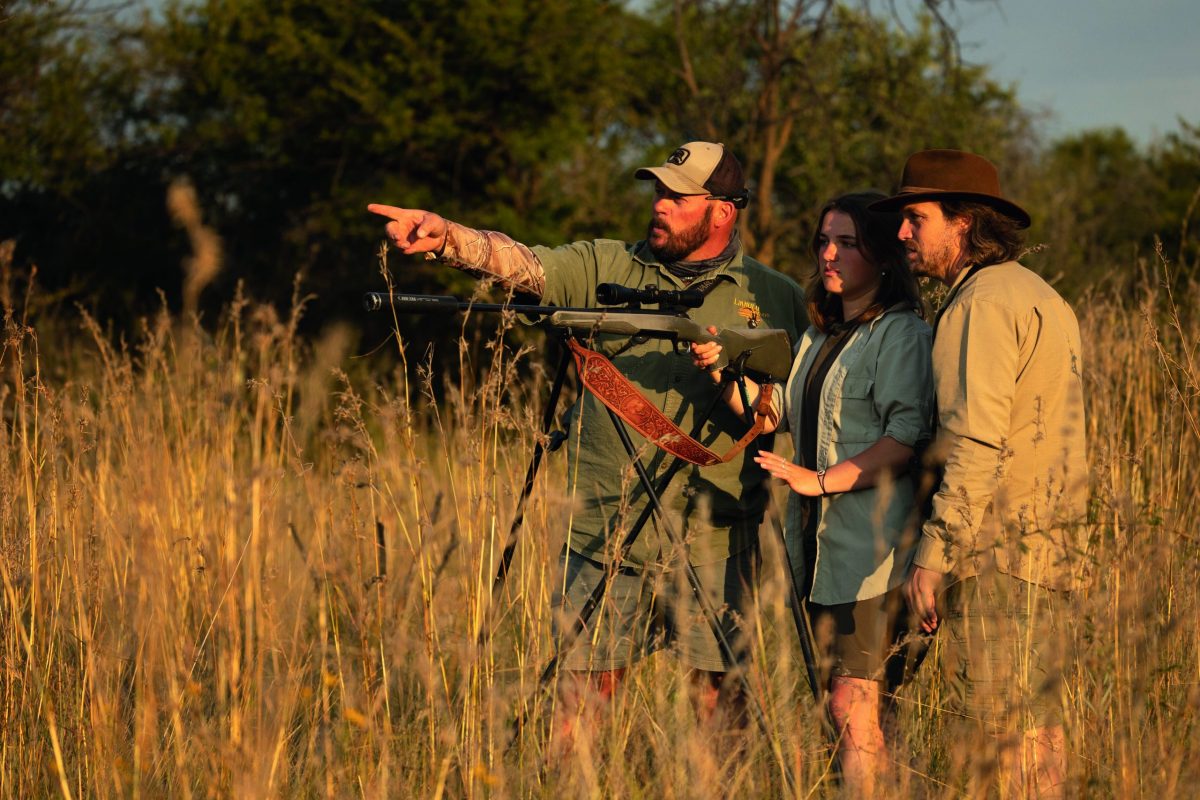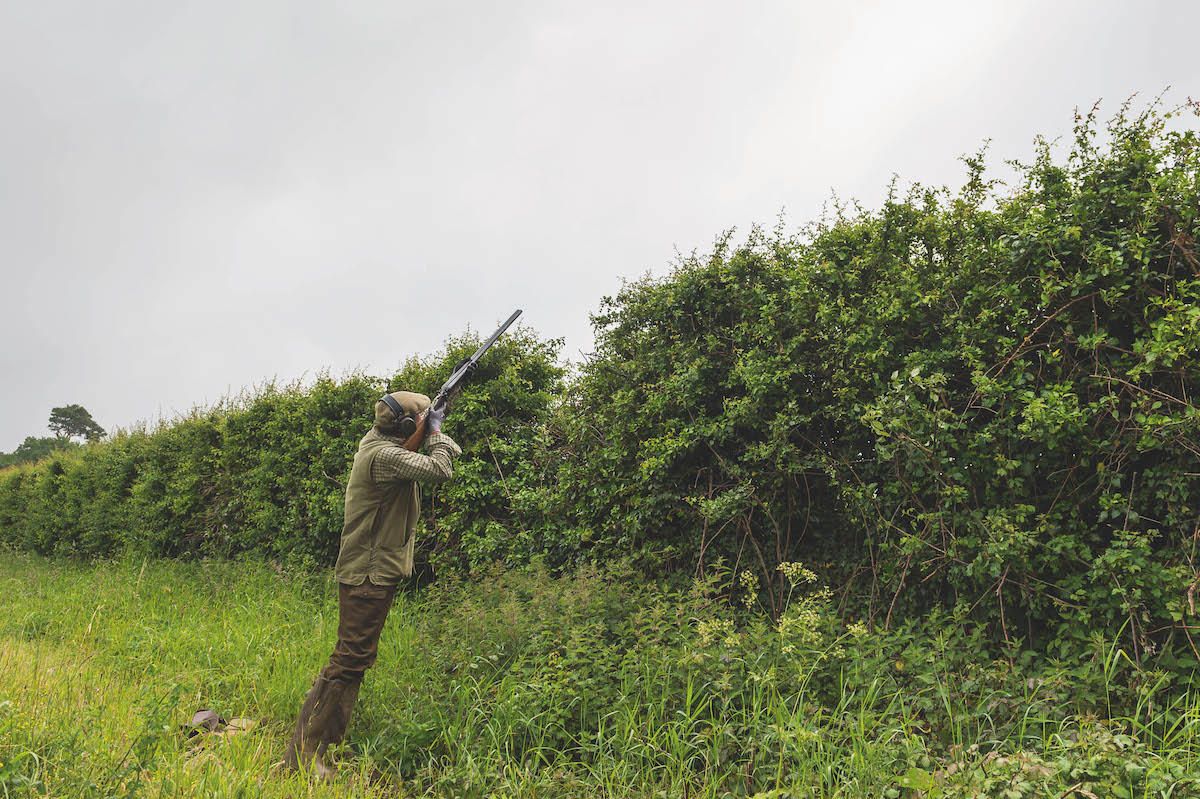Conservation in South Africa – sharing knowledge with the next generation
There’s no better place for a father to share his knowledge of conservation than a South African expedition, says Thomas Nissen

After Phoebe’s shot, PH Matt points out where he thinks the impala has fallen
Daniel Smith is one big smile as the vehicles pull up at the camp after his first day on safari. With the smoke from the bonfire tickling his nose, he stretches out a hand to take the ice-cold G&T the camp manager has poured for him. Life is good; he has just taken his first blue wildebeest following a great stalk.
Next to Daniel is his 16-year-old daughter, Phoebe, who has come with him on the trip in the hope of getting in on the action. She is no stranger to firearms and is a practised Shot with both rifle and shotgun, but Daniel knows the situation will need to be optimal if she is to make her debut
as a safari stalker during the trip.
A few days later, early in the morning, she gets her chance as an impala buck trots into range. Unfortunately, the situation gets the better of Phoebe. The longed-for opportunity — the chance to shoot one of Africa’s iconic species – has left her hands shaking so badly that she can’t get the shot away. Training doesn’t prepare you for the rich emotions that stalking can evoke and Phoebe’s reaction isn’t unusual under the circumstances.

Father and daughter both appreciate all their encounters with Africa’s animals, insects, reptiles and birds on this important trip
(credit: Thomas Nissen)
Luckily, she and her father are being guided by Matt, an accomplished trainer of first-time stalkers like Phoebe. He has helped her with every aspect of the expedition so far, offering sage advice on everything from handling the rifle while stalking to preparing to take the shot. Matt operates in hunting terrains across South Africa, including the north-western Limpopo province, where Daniel and Phoebe are stalking on this trip.
Today’s ground, which covers around 10,000 hectares, includes dense bush, savannah-like plains, high and low scrub, rocky outcrops and low mountains. The area was originally a vast cattle farm but now, like many other previously over-exploited agricultural areas in South Africa, it has been converted into a flourishing stalking ground with a diverse ecosystem of flora and fauna, including several huntable species. The owners of the terrain we’re on have introduced a wide range of animals, from buffalo and giraffes to ostriches and warthogs. Several antelope species — including kudu, nyala and impala — are also to be found here.
According to Matt, it rained constantly before our arrival. As a result, the grass is taller and the bush denser than the professional hunter (PH) has ever seen. Smaller animals, such as warthogs, are impossible to spot in the abundant cover, but it’s a different story when they cross the red dirt roads that cut across the landscape.
Calming
We come across one such group later in the morning, an hour or so after Phoebe missed her chance at the impala. A sow with piglets is leading the way, with a young male warthog trailing behind. It’s no prize animal, but Matt tells Phoebe she can shoot it if she likes. The teenager takes a deep calming breath before quietly moving behind her rifle, which is securely cradled in her Viper-Flex stick. She waits for the keiler to turn side on.
She is not flustered this time.
The hog turns, showing Phoebe a more generous target, and she releases a good shot. The hog falls, and Phoebe sighs with relief; she has secured her first beast with a rifle. It is neither the biggest nor the most beautiful animal, but perhaps that’s why she was less nervous this time.

Daniel lines up a shot on a warthog as Phoebe watches intently; the pair share a harmonious 10-day hunting trip
It’s almost evening when we spot more warthogs. We have spent the afternoon stalking along the dirt roads and have covered close to
5km when we come to an open area of grazed land where a sow and her piglets are rooting for food. Matt moves stealthily to set up Phoebe’s shooting stick, but the wary female detects movement.
Pausing her foraging, she scans the area, unsure of what she has seen. She is still weighing up the danger when a good keiler comes out of the tall grass to her left. Daniel knows that there’s no time to waste and promptly places a bullet in the young male’s neck. It falls straight away.
The kill caps a fantastic day; Phoebe has taken her first game animal and Daniel has succeeded in dropping a keiler despite conditions making an opportunity for that small species awkward. At the camp’s bonfire, the elated hunters toast each other long into the evening. The fact that you can see plenty of game on a South African safari does not mean it is easy to shoot.
Twitching
The following day, father and daughter spend the entire morning stalking and the whole afternoon at a waterhole without firing a shot. No suitable game has shown itself all day. With the sun dropping towards the horizon, Daniel and Phoebe decide to try stalking along one last dirt road. Suddenly, the tall yellow grass begins twitching 80m ahead of them. Seconds later, an impala buck appears.
Daniel quickly lines up his rifle in the shooting stick and sends his bullet squarely into the animal’s side. The gun’s report is still echoing when a strong male impala breaks cover in front of us. Matt and Daniel look at each other in confusion. They are sure that the targeted antelope is down, yet the buck racing away from us isn’t even wounded. The duo quickly and quietly head towards the shot site to confirm the initial kill and find the antelope’s body exactly where they expected it to be.
The impala they have just seen is a second animal. It is the rutting season and the party concludes that the two bucks must have been chasing one another. Knowing the second antelope is likely to return to search for its rival gives Phoebe an obvious chance.
Tiny click
Matt hastily positions her behind the rifle and points out the buck. It is a difficult shot and the animal moves several times just as she is about to shoot. When she finally crooks her trigger finger, there’s no bang, only a tiny click. For a moment, everyone assumes that Daniel has forgotten to reload, but when Matt silently pulls back the bolt, the bullet is still there — the gunpowder had failed to ignite, causing a misfire.
Pocketing the useless shot, Matt noiselessly slots a new round into the chamber, resettles the rifle and invites Phoebe to shoot. She takes her time, keeping the sight steady and hits the buck perfectly. After a short sprint, it falls headlong into the grass.

Daniel is ready to shoot but guide Matt says the waterbuck isn’t old enough for culling, so it is left
In the 20 years that Matt has worked as a professional hunter, he has never witnessed two prize impala bucks being taken from the same spot. And Daniel couldn’t have been more proud of his daughter. Phoebe had stayed calm and focused despite the tension and hadn’t even been fazed by the misfire.
The rhetoric of anti-hunt organisations nowadays frequently suggests that shooting is unsuitable and harmful for children and teens. In many countries, the groups have successfully lobbied to prevent youngsters from taking up the sport.
Poland’s new hunting laws, which prohibit people under the age of 18 from participating in a stalk, are a prime example. The objective of such legislation is to ‘cut the cord’ between parents and their children, by making it unlawful for adults to pass on their passion and knowledge of stalking, and its positive role in managing natural habitats. Consequently, it is more important than ever to show children and grandchildren what stalking is and the function it serves.
Phoebe often follows Daniel when he is stalking and it is clear that both have enjoyed their shared adventure in Africa. It’s rare to see a parent and their teenage child interact so harmoniously, but throughout their 10-day expedition — during which the pair shared accommodation, a PH and a rifle — there is no sign of friction between them. Perhaps that is the greatest prize of all.








